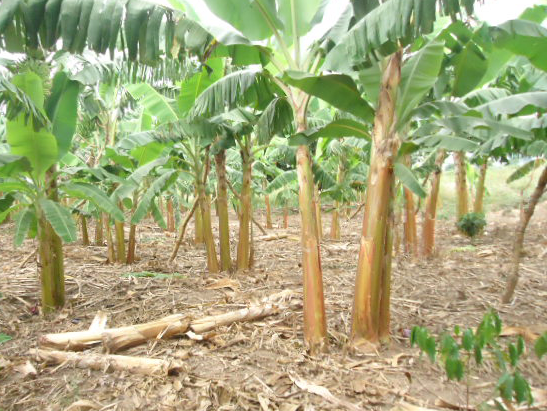AWODA Enhance production of Plantain (Gonja) in Kyenjojo
Plantains, commonly referred to as gonja, are a popular delicacy in Uganda. However, not many Ugandans grow it, in spite of its high demand and ready market. Association of Women Development Actors, a women led community based organization is championing the production of plantain (Gonja) in Butiti sub county, Kyenjojo District.
Plantain is a member of the banana family. It is starchy, low in sugar and can be cooked or roasted over fire, as is the case in Uganda.
This plant takes about one and half years to produce a bunch of bananas, after which the mother plant dies. But new suckers sprout around its base.
The current situation
In most markets in Uganda, a small bunch of plantains costs about sh20,000. Just two fingers of plantains cost sh 1,000. And yet, growing this delicacy across the country is not as widespread as any money spinner should be.
Many farmers spend money on gonja, yet they could grow it themselves. It is just a few farmers, who are earning from it.Most of the gonja is imported from the Democratic Republic of Congo.
Personal testimony
In 2013, with support from Swiss League of Catholic Women, AWODA piloted the production of plantains in Busanza parish,Mukunyu in Kyenjojo. With only 50 suckers from COSIL model farmer in Kamwenge
It was realized Plantains take almost six more months than ordinary bananas to grow, but that this didn’t deter farmers who continued planting them and at the moment, have over 150 plants,
The fact that they have done well on farm is testimony to the fact that Ugandans can produce across most parts of country.
How to grow Gonja.
Like other bananas, gonja is propagated vegetatively. The types of planting materials used are peepers, sword suckers and maiden suckers. Peepers are young suckers appearing above the ground with large scale eaves only.Sword suckers are formed from buds or eyes and bear narrow leaves. Maiden suckers are taller, with broader leaves.
The recommended spacing is 10ft (3m) x 10ft (3m) and a depth of 0.2m at the onset of the rainy season. About 400 suckers can be planted on one acre.
The dry leaves should be pruned at the beginning of the rainy season and not during the dry season. This helps protect the stem from extreme sunshine, minimizing evaporation.
Gonja matures in about 16 months.
It is tolerant to the banana weevil. The eggs of the weevil are laid at the base of the sucker so after harvest, the leaf crown and the stem should be cut at the ground level to avoid infecting the other plants.
Advantages
Plantains are more resistant to pests than other banana species.
The price of a bunch ranges from shs. 10,000 to sh. 20,000 for small and medium bunches respectively. Bigger bunches cost a lot more.
Health benefits
Other than the financial benefits that accrue from growing gonja, it is also a major source of vital nutrients. Gonja is rich in vitamin A, which helps check poor night vision, dry inflamed eyes, dry and rough skin, diarrhoea and loss of appetite.
The plantain also increases resistance to infections such as a cold.
Severe deficiency of Vitamin A may cause weak bones and teeth and in extreme cases partial blindness.
Steamed gonja comprises vitamin B6 and C, which boost immunity. Vitamin C plays a significant role in the production of collagen, a structural protein that strengthens blood vessels, aiding body tissue development and boosts immunity to diseases.
Gonja improves body flexibility by energizing the body thus reducing fatigue and acting as an anti-depressant.
The plantain also supports brain function, boosting memory and checking nervous system disorders and anaemia.
Doctors recommend three servings of plantain per week to keep healthy. For this August –December 2017 season we have given more four farmers to establish demonstration plots, giving each at least 100 suckers, we believe in the next one year we shall be giving more farmers.
AWODA program volunteer giving out the suckers


Demo garden for Plantain


